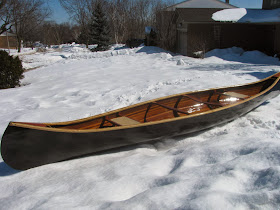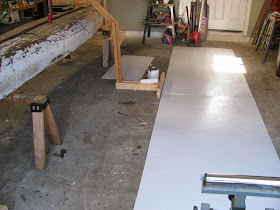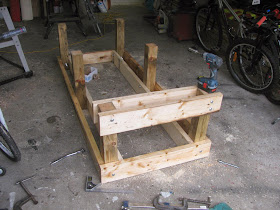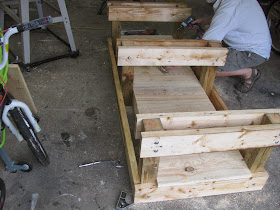Thursday, 26 December 2013
Wednesday, 13 November 2013
Refinishing a stripper canoe
Not our usual fare, a strip built canoe landed on our doorstep one afternoon. Hard to pass up, as its a very well built stripper, with some nice details and a nice smooth outer skin. The inside has the usual bumps owing to the difficulty of laying, smoothing and filling near vertical surfaces with fiberglass and epoxy. Still, with cherry seats, decks and thwarts it will look nice with fresh varnish. The exterior has been painted, to our delight. While some folks prefer 'the beauty of the wood' under the clear glass, the many different strips of wood, from many trees, makes these the hot dog equivalent of a canoe. Essentially a sandwich , or wood core, construction - that is, a core material between two layers of fiberglass - the boat derives its strength not from ribs but the inner and outer layers of glass, in compression and tension respectively. The most common method of finishing is to varnish them and leave them clear.
Enter our affinity for black canoes, although traditionally built antique boats typically have too many lumps and bumps to look good gloss black. Strippers, however, are comparatively more static, with little or no material movement. This one will see us indulge our want of a black boat, with a two part polyurethane finish, polished brass stembands, and new white ash outer gunwales.
Not unlike traditionally built boats, while more durable when left to the elements, the wood parts that end up exposed suffer the same. This one needs new outer gunwales, tip work on the inners, the keel sealed with penetrating epoxy, and an overall sand and varnish.
Enter our affinity for black canoes, although traditionally built antique boats typically have too many lumps and bumps to look good gloss black. Strippers, however, are comparatively more static, with little or no material movement. This one will see us indulge our want of a black boat, with a two part polyurethane finish, polished brass stembands, and new white ash outer gunwales.
Not unlike traditionally built boats, while more durable when left to the elements, the wood parts that end up exposed suffer the same. This one needs new outer gunwales, tip work on the inners, the keel sealed with penetrating epoxy, and an overall sand and varnish.
That famous and familiar stripper interior, with 'football' shaped interior where the planks must fill the bottom. With no gored or spiled planks, the curve is carried to the centre line.
Nice upswept bow, the distinctive shape of Ted Moores design from his book Canoecraft
Sitting outside has taken its toll on the cherry gunwales, which had to be cut and split off the boat as they were screwed and bunged.
Carry thwart, center thward and seats, all from Cherry
Nice smooth hull, minimum preparation before the applicatoin of LPU.
Nicely outfitted with cherry.
Bow section showing the damage to the gunwales.
Selection of Japanese tools, for gunwale removal
Replacement parts! Prewoven cane, spline, paint and marine oil.
Just about the best paint going, Epifanes 2 part polyurethane will give great gloss, and abrasion resistance. A very tough 2 part coating.
Progress fell off for a while, but sanding is done
Ash gunewales coming back nicely, will look nice against new ash outwales.
Weapon of choice, Milwaukee random orbital sander
Next steps - epoxy seal inner and outer gunwales, varnish interior and seats/thwarts, then flip her over and sand the hull to prep for 2 part epoxy paint. Gonna be pretty...
Finally back at it, interior is wiped with thinner and a tack rag. Seat frames and thwarts, hanging nearby get the same treatment.
Half done, the wood coming up nicely.
Finally back at it, interior is wiped with thinner and a tack rag. Seat frames and thwarts, hanging nearby get the same treatment.
Near the end of the first coat, new outer gunwales getting coated as well. Some yellowing in the interior cloth, common as these boats age. A few more coats and on to the outer hull.
Its finer in primer. One more step till the gloss black - quick hand sanding of the pimer that we tinted with black so it wasnt such a bright white.
Hanging nearby are the cherry seats and thwarts
Mixing Epifanes 2 part polyurethane. Not the best colour or finish for a traditionally filled canvas, but on a stable 'glassed stripper perfectly suited
Instant gloss!
Half done, a lot quicker than sanding the primer.
Glossy! first coat, thwarts back in. Seats next, then fit gunwales
Still to do: sand paint to prep for final coat, then hand sand interior, parts and gunwales for finish coats of varnish.
Then wait for winter to end - this one really is going on too long. Should have covered the
IC project!
Any shiny canoe looks great against the snow!
Classic lines of Ted Moores' Redbird design
Shiny, Shiny.
Cedar hull, ash inner and outer gunwales, all the rest black cherry.
Another one done.....
Saturday, 19 October 2013
Material Gathering
Just as birchbark canoe builders gather bark, spruce gum, cedar, and spruce roots, the building of a cedar canvas canoe requires the gathering of materials as well. In order to build authentic replicas of the early Chestnut Guide, we are adhering to its original configuration and list of materials. White cedar ribs and planks will, along with maple for the seats, thwarts and decks are not difficult to source , and even white oak for stems has been procured. What does prove difficult however is long lengths of spruce for gunwale stock, either for single, closed gunwale construction or for the later style of open gunwale with both and inner and outer. Chestnut was building in both styles before the factory fire of 1921. During a weekend north walking the woods hunting for grouse, we visited a sawmill who had 2 30' logs they agreed to mill for us in an attempt to pruduce some clear stock. Ash gunwales, or even cherry or oak are not over scarce, but clear spruce in lengths over 17' are rare as trees are both smaller, and no one cuts in those lenghts. Lumber piles yield large rafter stock, however it has always been kiln dried and wont bend well afterwards.
Small pile of big cedar
Milling the log, 19' section
Second log
Moving stock around
BIG bandsaw
Starting to load - nice long stuff, much clear throughout.
The write up of the Guide model early on specified that the lumber is not as selected as with the pleasure, and small knots and imperfections were allowed so long as they didnt weaken the board. As in many canoes, they can be hidden behind ribs where possible, however even our example has small knots visible in some areas. This was a Guides canoe after all, and with the heavier canvas it was meant for working.
Tuesday, 1 October 2013
Lofting (or taking lines) off the Chestnut Cruiser/Guides Special - or, 'what i did with a few days of a week off'.
Our super rare find earlier this summer, is down from the rafters in preparation for having its lines taken off. Far too complex a process to describe in detail here, lofting is the process of drawing out the boats shape, accomplished by effectively rendering sections of the boat, as though viewed while being sliced into sections. Proving the measurements taken allows for the lines to be corrected, since the finished craft will inevitably have moved, or changed shape, anywhere from its initial build and throughout its life, up to present day. This allows for an accurate set of plans to be drawn up, and a building form to be made from the plans to build exact replicas of the boat being copied. In our case, the only unmodified pre-fire cruiser currently known to exist.
Want to move through the North country as Thomson did? The first step is to have the boat he used.
And so it begins....
It begins with an import mini van? Sure, the easiest way to get 4x8 sheets of plywood back to the shop. The smooth veneer plywood will be painted with flat white paint, in order to use pencils and battens to determine the curves as they come off the boat.
Next is a thorough cleaning of the shop, long overdue. Thats followed by brooming the floor, and a vacuuming to get everything up off of it - staples, tacks, screws, all the stuff thats fun to kneel on.
Finally clean, this is where the plywood will be laid out for measurements to be transfered.
Fingers are used to take several measurements off of the boat, including sheer, baseline, and many points along the hull once everything is set up, trued and leveled.
Uprights are not yet in place for the string which will be used as a baseline.
Plywood is laid out alongside the boat, as everything will be done full size, or 1:1. Often lines are given in a table of offsets which then need to be lofted out full sized, however this method is done actual size.
Not the way a lot of people would spend their week off, but we've been looking forward to this with much anticipation since collecting the boat.
The first of two coats of flat white is on and drying.
More to come after the paint dries...
Baseline is set up and leveled, after uprights are put in place.
Rocks are handy and weight down the posts so the string can be drawn tight.
Boat is leveled under string.
Distance to baseline string recorded, and ready to start
Extra fingers, nails for battens, lots of pencils and sharpeners
Kneepads are essential when working on concrete floors!
First station being taken
Another view
First station profile, now its getting exciting as the anticipation fades into action.
Few more
Half of one side, or one quarter of boat done. One more quarter will be done, and the lines proven and made fair, taking out a century worth of bumps and movement.
The stations are all taken, and there is some work to do to fair everything as it shows some movement in the hull. No matter, it will all be straightened and cleaned up
Last step is to take the stem profiles, which are part of what makes the Cruiser so distinctive
Going to need some flexible battens longer than the boat. 18' clear pine, 18" wide, is what the form will be built from. We can spare an inch width to saw up some battens.
Half breadth view, widest portion of boat
Lumps taken out, first stage of fairing lines.
Waterline 3" below widest point of boat, showing amount of tumblehome
Tumblehome carried into ends of canoe.
Write up of the Guide Model
Tom Thomson out in his Guide model.
Shot of a canoeist attributed as Thomson, thought to be Canoe Lake
Above is a copy of Thomsons Guide License. Perhaps not as well known as his exploits in the park as an artist, is the fact the he also guided tourists in the park. When a new canoe from Chestnut was over $30 at this time, a dollar was not a cheap license at the time. Below is a picture of a party being guided; while we have it listed elsewhere on the site, its entirely appropriate at this time.
In fact, in these early days in the park, after the decline of the birchbark canoe in favour of the manufactured cedar canvas canoes, aside from EM Whites, which were used at camps such as Keewaydin, Chestnut was one of, if not the only, manufacturer of canvas canoes in Canada at the turn of the last century. Peterborough, when they began canvas canoe production, was using some of their early board canoe forms, and surviving models show the hybrid construction. These early canvas boats have shelf gunwales, usual for a board or strip canoe. Chestnut employed closed gunwale construction which was popular on the East Coast, among makers like Gerrish, White, Morris and Old Town. Cross boarder tarrifs, steep at the time and affecting many goods flowing between Canada and the US, made importation of US boats less attractive than domestically produced Chestnuts - this is said to be one of the motivators of the Chestnut family's decision to enter the canoe business. The above boat, and indeed many in early photos, are clearly Chestnuts.
Above is an early Chestnut Pleasure model, as evidenced by the sheer line and heart shaped decks, as opposed to the early Cruisers deck.
The progress continues, here adjusting the sheerline before proving the waterlines.
Ends are looking sweeter!
Starting to look like itself
Midsection smoothed out. Once done and the half breadths complete, the waterlines can be proven and construction can start on the building form.
Better batten, better curve. Sheerlines cleaned up
Correct heights at the ends, and the right amount of rise
Profile view is complete, next task is to fair the waterlines.
Maple decks in place and intact, showing the nice crown across the top, and cuticle cutout. Quite a bit apart from the heart shaped decks of the Pleasure model.
As with so many old boats we find, the caning has long since failed and with a nod to utility, the owner has covered the seat with a board. Not the prettiest, but quicker and more durable to be sure.
Underneath, remnants of the classic caning pattern in use up till the end.
Front seat was covered some time later, as it now exhibits plywood. Although the first patent for what could be called plywood was issued December 26, 1865, to John K. Mayo of New York City, with its rich forest resources, it was only natural that Canada should join what eventually would become a truly North American plywood industry. The first Canadian plywood was produced in 1913 at Fraser Mills, New Westminster, British Columbia, but it wasn't until 1935 that a second mill was opened-by the H.R. MacMillan Company. Likely it wouldnt have become widely available immediately, so while this may or may not be an early piece of plywood, the point is that the boat had seen heavy use in its first decade or two of life.
Empty front seat, waiting to be re-caned. These parts, along with thwarts, will be made well in advance of the hulls, and put in as them come off the form.
Finally after a long break and a crazy summer and fall with work, we are ready to return to the corrected lines and trace the stations. Kids like the large work surface! Stations will then have to be reduced for sheating and steel bands used in the form construction, as well as for ribs, planks and canvas since the lines are lifted off of the outside of the completed hull.
Now its getting exciting, one step closer to a new, 106 year old cruiser!
Another shot.
Back at it, no stopping till we have a boat. First thing is a platform for the form, both to build it on and to hold it up while we build on it. Most forms will weigh a significant amount, the last one took two of us to move. Never weighed it, but north of 200 lbs. seemed likely.
Frame work waiting for shelf , casters and the rest of the cross bars.
Nearing completion.
Another shot.
Waiting for sintered iron casters, nylon or plastic arent up to the task.
Taking off stations from lines onto velum paper to be transfered to the plywood stacked on the platform.
Working in view of the original. Full size profile will come down to provide stem profile, distance from last station, verify sheer and check set up.


























































































